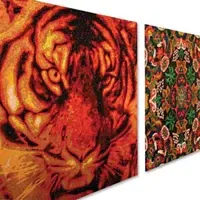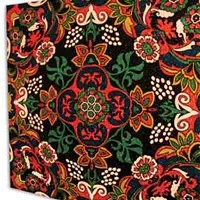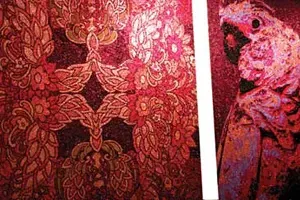Dangerous Eye Candy
Written by

By Mark Amery
The expression ‘beauty is in the eye of the beholder’ might at first seem misleading. After all, the culture around us, not the individual, tends to dictate to us what beauty looks like. But what of those who see things differently, based for example on their sexuality or cultural perspective?
Works of art have over history dominated our ideas of what is beautiful. Yet when these works were first presented they were often a disturbance, a challenge to popular taste. Artists are in the business of testing and stretching our visual language - exploring what lies below how we represent ourselves, and the world. That’s why appreciation of great art can take time to become widespread. It slowly burns away in the collective mind until it eventually comes alight.
Such big thoughts blew through my head at Pataka museum in Porirua, sitting in front of the small glittering wonderland that is Reuben Paterson’s suite of six paintings She Beauty, He Beast. They bedazzle you while also presenting images that have become ordinary clichés of beauty. Importantly, they seduce you for long enough to get you start questioning what exactly it is you’re looking at, and what it all really means.
Now well-established as an artist, Reuben Paterson’s exquisite use of a material we employ to give the everyday a sprinkle of magic dust – glitter - lifts things out of the real world to let us consider them anew. The patterns and images he adapts are seductive in their familiarity and kitschness, but also in how they have become suddenly, shimmeringly strange.
These paintings really work at giving you maximum joy and pleasure. You bathe in their warm glow. Yet in an age when you can get a photograph reproduced on a birthday cake in icing, mechanically producing a design out of glitter could be a matter of money rather than skill. The idea of these works sounds as tasteless as an overuse of gold or gems. Yet their exquisite intricacy, as you step towards them and the imagery morphs into the abstract, suggests no ordinary craftsperson. You find yourself questioning how much of their effect is their reproduced excess of effect and how much the artist’s ‘art’. This is part of their beautiful tension.
Paterson’s source material here are patterns and imagery found on domestic fabrics. Paintings of a panther, a tiger and a budgerigar are paired with complex patterns.
Caught mid roar, its teeth bared, the panther would seem to have it in for the budgie on the facing wall - as the tiger would us, staring us down as we enter the gallery. The tiger work is entitled ‘Estrous’, a fancy word for an animal being on heat. These works are certainly in colour and vibration hot and seductive.
Yet the images are also instantly recognisable from well-worn towels and bedspreads. As images of fear and beauty they have over time become well and truly tamed. Paterson pumps sexuality and meaning back into figures and patterns (Paterson’s Maori artistic heritage comes through in this respect).
The selection of imagery and their arrangement reminds us how images of danger and sexuality have become an unthinking part of our lives, even when we are naked. As such they seem to me symbolic of the violence that runs unseen publicly through domestic life.
On this fresh inspection a pattern proves to be full of representations of fertility and sexuality (rather unsubtly its titled ‘The Bedspread of Provocation’). The black panther, emerging from brilliant midnight blue, is entitled ‘Nigger’. The complexity of what is considered stereotypically beautiful and dangerous is teased out.
The wall label tells us that Paterson is highlighting the inequality of the ‘gay panic’ provocation defence for murder that was in place before a repeal of the Crimes Act in 2009. That may have fired up the artist, but it seems pretty irrelevant to our appreciation here. The exhibition title itself is enough to reinforce that what is beautiful and what is beastly depends on the eye of the beholder.
Ultimately these paintings provide beautiful music that can take you many different places. Moving closer to them there is the illusion of movement (you feel the influence of op art) and rich changes in the surface pattern.
Within the image of the black panther I find myself swimming in a glittering black sky. This then turns into a current of the Pacific, moving my eye to the gem encrusted sandy shores of an atoll (the teeth of the animal). Taking another step back however the animal’s long whiskers turn into jagged violent shards of stained glass.
What is beautiful it turns out depends on how long you look, and from what position.
She Beauty, He Beast, Reuben Paterson, Pataka Museum, Porirua, Until 15 May


